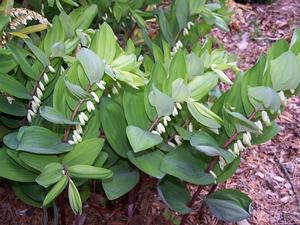View All Plants :: View All SHADE PERENNIALS
Polygonatum odoratum var. pluriflorum 'Jinguji'
European Solomon's Seal
Plant Type:
SHADE PERENNIALSPolygonatum odoratum var. pluriflorum ‘Jinguji’ – This beautiful Solomon's Seal sports arching maroon-red stems which are clad in ovate green leaves in the typical architectural display which is one of the fantastic features offered by all the polygonatums. Lovely white bells with a touch of green at the flower tips dangle from form short axillary stems in spring followed by blue-black berries in autumn. Purchased from Jinguji Nursery in Japan this exceptional Solomon's Seal came to the west coast via Dan Hinkley and was briefly offered at the original Heronswood Nursery. 'Jinguji' is a moderate increaser with a clumping disposition. Division.
Characteristics and Attributes for Polygonatum odoratum var. pluriflorum 'Jinguji'
Season of Interest (Flowering)
- Spring
Season of Interest (Foliage)
- Spring / Summer / into Autumn
Autumn Interest
- Fruit / Berries / Seed Heads
Nature Attraction
- Deer Resistant
Light
- Morning Sun / Afternoon Shade
- Dappled Shade
- Shade
Attributes
- Woodland
- Border
- Ground Cover
Growth Rate in the Garden
- Medium
Soil
- Fertile
- Woodland
- Draining
Origins
- Japan
Propagated By
- Division
Genus Overview: Polygonatum
Common Name: Solomon's Seal
These are the architectural Solomon Seals, all strong contrasting counterpoint to other denizens in the woodland/shade garden. Solomon Seals form spectacular colonies of upright arching stems from rhizomes just under the surface soil and leaf duff. Allan Armitage writes in his 2nd edition of Herbaceous Perennial Plants, “The common name Solomon’s Seal may have been derived from the circular sunken scars that remain on the rootstock after the leaf stalks die and fall off; the scar somewhat resembles a seal impressed on wax on official documents or letters in former times.” The simple leaves are obovate to elliptic turning yellow to golden brown in autumn before dropping. All prefer open shade to morning sun. When flowers are pollinated dangling blue fruits may develop on short paired pedicels along stems from leaf axils. All of the following offerings are by pot grown established division.


